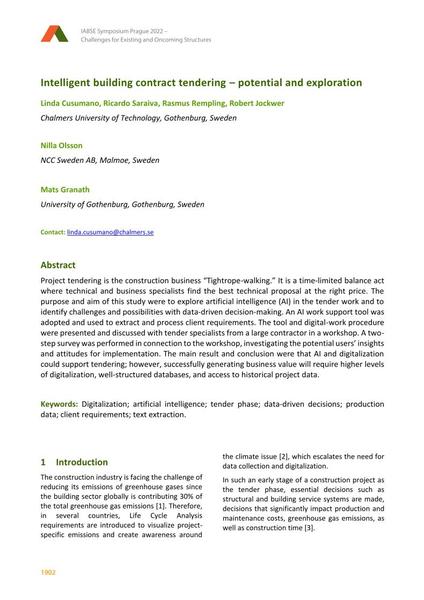Intelligent building contract tendering – potential and exploration

|
|
|||||||||||
Bibliografische Angaben
| Autor(en): |
Linda Cusumano
(Chalmers University of Technology, Gothenburg, Sweden)
Ricardo Saraiva (Chalmers University of Technology, Gothenburg, Sweden) Rasmus Rempling Robert Jockwer (Chalmers University of Technology, Gothenburg, Sweden) Nilla Olsson (NCC Sweden AB, Malmoe, Sweden) Mats Granath (University of Gothenburg, Gothenburg, Sweden) |
||||
|---|---|---|---|---|---|
| Medium: | Tagungsbeitrag | ||||
| Sprache(n): | Englisch | ||||
| Tagung: | IABSE Symposium: Challenges for Existing and Oncoming Structures, Prague, Czech Republic, 25-27 May 2022 | ||||
| Veröffentlicht in: | IABSE Symposium Prague 2022 | ||||
|
|||||
| Seite(n): | 1902-1909 | ||||
| Anzahl der Seiten (im PDF): | 8 | ||||
| DOI: | 10.2749/prague.2022.1902 | ||||
| Abstrakt: |
Project tendering is the construction business “Tightrope-walking.” It is a time-limited balance act where technical and business specialists find the best technical proposal at the right price. The purpose and aim of this study were to explore artificial intelligence (AI) in the tender work and to identify challenges and possibilities with data-driven decision-making. An AI work support tool was adopted and used to extract and process client requirements. The tool and digital-work procedure were presented and discussed with tender specialists from a large contractor in a workshop. A two- step survey was performed in connection to the workshop, investigating the potential users’ insights and attitudes for implementation. The main result and conclusion were that AI and digitalization could support tendering; however, successfully generating business value will require higher levels of digitalization, well-structured databases, and access to historical project data. |
||||
| Copyright: | © 2022 International Association for Bridge and Structural Engineering (IABSE) | ||||
| Lizenz: | Die Urheberrechte (Copyright) für dieses Werk sind rechtlich geschützt. Es darf nicht ohne die Zustimmung des Autors/der Autorin oder Rechteinhabers/-in weiter benutzt werden. |
||||
